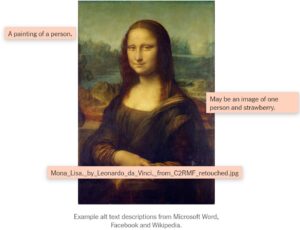Why Use Inclusive Design and Accessibility?

CDC’s infographic of disabilities within the US
Whilst creating a project that relies so much on the senses of the audience, it’s vital to remember and include those who don’t match with our preconceived human interactions or lifestyles. Of course, when considering accessibility and inclusion, the first thought often goes to those experiencing disability, which makes up over 21 percent of people in the United States. But, disability isn’t one clear term and can apply to those with permanent, temporary, and situational disabilities. It’s with these populations, and the broader communities around them, that it is important to make all deliverables and technology accessible and inclusive to those who use them.
How will I Implement Inclusive Design and Accessibility in My Capstone?
The Art Exhibit:
In my project, I have to acknowledge immediately that the sense of sight is the foundation of all my content. As the biggest point of my art exhibit, it would be difficult for anyone experiencing blindness or sight difficulty to fully experience the paintings and interpret them in the same ways that sight-abled audiences could. Thus, I must start considering and implementing accommodations to my exhibit to make sure all audiences can enjoy and understand the paintings with the same levels of comprehension and engagement. Seeing how this is a completely online exhibit, I have the opportunity to utilize technology to my advantage, using tools such as auto alt-text and even audio alternatives if alt-text isn’t available. For each painting, I’d include descriptive and clear alt-text to allow viewers to understand the painting to the fullest capability, which would describe color, form, and subject matter in detail. Having this capability would be helpful to not only those experiencing permanent or temporary blindness or sight difficulties but also to those in situational sight-disability such as temporary light sensitivity or display issues.

What NOT to do when using alt-text to describe art
Additionally, I have to consider those who experience disabilities in mobility and touch. When using a program that acts as a virtual museum, I must make sure that the program is user-friendly, not requiring high functioning motor skills or mobility to be functional, and instead is easy for all users to use with little to no extra effort of skill. So, taking inspiration from museums that use accessibility functions such as space bar navigation and clear functionality, I have focused on finding programs that allow for easy accessibility and use, rather than more complicated ones that require heavy motor skills and use to navigate the digital gallery. This will be helpful for situational motor disabilities such as a new parent, impatient users, and so forth.
Marketing Campaign:
For my marketing campaign, as it also is a mainly visual-based set of deliverables, I will have to consider sight disabilities in another context. As my print ads and digital media posts will be less technologically advanced compared to the exhibit, I will use alt text in the form of descriptions and use accessibility tools available to my social media posts. Additionally, I will also consider color as a larger factor, making sure that my deliverables can transfer to grayscale and different color blindnesses, make sure to use high contrast or simpler designs near the text, and be sure my typography is legible on different assistive devices. This will help the same situational groups as mentioned above, with people with light sensitivities, lighting situations, and display issues on their technologies to enjoy the content to the same extent as sight-abled communities.

Color wheels shown under different variations of color-blindness
How Will These Deliverables Get to All Audiences?
Going so far as to think about how my finished content will be delivered to audiences, it’s important that I also consider inclusion in how I spread my project and news about it to all target communities. As stated in previous posts, I would like my target audience to be a large age range and socioeconomic background, with the main defining features of them being that they have an interest in art, history, or food, and are open to learning about food in art history through different cultures. But, with such a diverse audience, I need to make sure that my content isn’t hidden behind potential pitfalls such as paywalls, technology affordances, or lack of marketing to certain audiences. That being said, I plan on sharing my content through my website emmarmccormick.com, having it available for viewing on my chosen virtual gallery platform, and maybe uploading it to different social media to have it be available through numerous sources. Additionally, I plan on sharing news about my project that same way, making sure anyone can see it so long as they have internet access. With diversity and inclusion embedded into my project, I hope to reach and engage with the largest audiences possible and have everyone enjoy the content to the furthest extent possible.

March 12, 2022 at 2:35 pm
So great, Emma. Really enjoy how you are thinking through these complex issues. I would have enjoyed a bit of discussion about how the exhibit software affords the use of ALT text, and I look forward to seeing it after you’ve started.
Bill